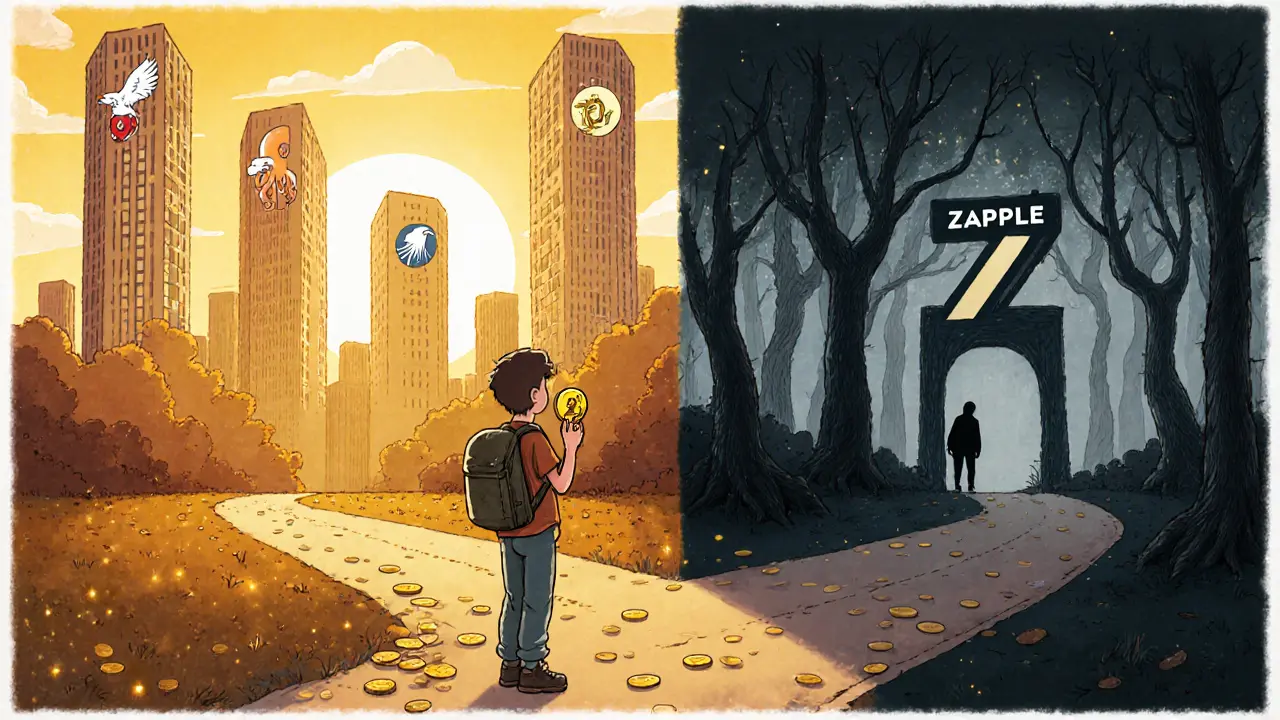Key Takeaways
- Public information on Zapple is virtually nonexistent, which raises caution flags.
- Compare Zapple’s claimed features against established platforms like Coinbase and Binance US before depositing funds.
- Use a safety checklist for any new exchange: regulation, security, transparency, and user support.
- If Zapple cannot prove KYC, AML, or cold‑storage practices, treat it as high risk.
- Start with a small test trade and monitor the platform’s responsiveness for at least two weeks.
When you type Zapple crypto exchange review into a search engine, you probably expect a clear rundown of fees, security, and supported assets. The reality is that reputable sources such as NerdWallet, Money.com, and ICOBench have no record of a platform called Zapple. That silence itself is a data point. This article walks through what we can actually verify, how Zapple stacks up against well‑known exchanges, and which red‑flags you should watch for before risking any money.
What We (Don’t) Know About Zapple
First, let’s define the subject. Zapple Crypto Exchange is purportedly a cryptocurrency trading platform that claims to offer spot and margin trading, a mobile app, and fiat on‑ramps. A deep dive into industry‑wide review sites, regulatory filings, and blockchain analytics yields zero mentions. No press releases, no audited financials, no public security audit. The only trace is a domain that resolves to a generic landing page with a sign‑up form.
Because the ecosystem relies heavily on transparency, the lack of publicly available documentation suggests Zapple is either a brand‑new venture that hasn’t attracted coverage yet, a regional service with limited reach, or possibly a re‑branded version of an existing platform.
Red Flags When Evaluating Unfamiliar Exchanges
Even if Zapple eventually gains traction, you can gauge its trustworthiness by checking for these common warning signs:
- Regulatory registration: Are they listed with the SEC or local financial authority? Absence of a registration number is suspicious.
- Security disclosures: Look for third‑party audits, bug‑bounty programs, and documented cold‑storage percentages. Established platforms like Kraken publish audit reports annually.
- Team transparency: Real names, LinkedIn profiles, and verifiable crypto‑industry experience matter. Anonymous teams often hide past failures.
- Fee clarity: Hidden spreads or “zero‑fee” marketing that later translates into high slippage is a red flag.
- User support: 24/7 live chat, responsive email, and a clear escalation path indicate operational maturity.
Feature‑by‑Feature Comparison
| Exchange | Supported Cryptocurrencies | Base Trading Fees | Security Measures | Regulatory Status | Mobile App Rating (iOS/Android) |
|---|---|---|---|---|---|
| Zapple | Not publicly disclosed | Not disclosed (claimed “0%”) | Unverified - no audit links | Unclear - no regulator ID | 5‑star claims, no store reviews |
| Coinbase | 235+ | 0%‑3.99% (varies by volume) | Cold storage for 98% of assets, 2FA, insurance fund | Registered with FINCEN, US SEC compliance | 4.8 / 4.7 |
| Binance US | 158 | 0%‑0.6% | SAFU fund, 2FA, cold storage 95% | NYDFS trust charter, US compliance | 4.6 / 4.5 |
| Kraken | 350+ | 0%‑0.4% | Encrypted cold storage, 2FA, proof‑of‑reserves | FINCEN registered, US AML/KYC | 4.7 / 4.6 |
| Gemini | 120+ | 0.03%‑3.49% | FDIC‑insured custodial accounts, 2FA | SEC‑registered trust | 4.5 / 4.4 |
| Uphold | 50+ | 0.2%‑2.95% | Multi‑sig wallets, 2FA, insurance policy | FINCEN registered, NYC charter | 4.3 / 4.2 |
The table highlights that Zapple currently offers no verifiable data. Every reputable exchange lists its asset count, fee schedule, and compliance credentials openly. That transparency gap alone should steer cautious traders toward platforms with proven track records.
Checklist Before Using a New Exchange
- Verify the domain’s SSL certificate and WHOIS registration date. New domains (<2years) are higher risk.
- Search for third‑party security audits (e.g., CertiK, Trail of Bits). Absence = red flag.
- Confirm KYC/AML procedures. If the platform lets you trade without identity checks, expect strict limits or possible shutdown.
- Check if the exchange holds a banking partner or a trust charter. Look for regulator IDs on the “About” page.
- Read community forums (Reddit, Bitcointalk) for real‑user experiences. Watch for repeated complaints about withdrawal delays.
- Test the withdrawal process with a tiny amount (e.g., $10). If the money gets stuck, abandon the platform.
- Ensure the platform supports hardware‑wallet withdrawals. If you can’t move funds off‑exchange, you’re effectively handing over custody.

Security Basics You Should Enforce Everywhere
Regardless of which exchange you pick, follow these universal security habits:
- Enable two‑factor authentication (prefer authenticator apps over SMS).
- Use a unique, strong password stored in a password manager.
- Activate withdrawal whitelist IPs if the exchange offers it.
- Regularly review account activity logs for unknown logins.
- Move long‑term holdings to a hardware wallet (Ledger, Trezor) as soon as possible.
Final Verdict on Zapple
Based on the evidence (or lack thereof), Zapple sits at the highest end of the risk spectrum. While it may launch a competitive product in the future, the absence of verifiable fees, security audits, and regulatory registration makes it unsuitable for anyone with more than a few dollars to spare.
If you’re intrigued by the brand, keep an eye on official announcements, but start with a well‑established exchange for core trading activity. Use Zapple only after it publishes a clear fee schedule, obtains a regulator charter, and provides an independent security audit.
Frequently Asked Questions
Is Zapple a legit cryptocurrency exchange?
As of October2025, no reputable review site or regulator lists Zapple. Lack of public information suggests high risk. Until it publishes audits and registration details, treat it as unverified.
What fees does Zapple charge?
The platform claims “0% trading fees,” but no official fee schedule is available. Without disclosed spreads or withdrawal costs, the claim cannot be validated.
How can I verify an exchange’s security?
Look for third‑party audits, cold‑storage percentages, two‑factor authentication, and insurance funds. Reputable exchanges list these details on their “Security” pages.
Should I move my funds to a hardware wallet?
Yes. Keeping large balances on any exchange exposes you to hacks or custodial failures. Transfer only the amount you need for active trading.
What are the warning signs of a scam exchange?
Unclear ownership, no regulator ID, missing audit reports, promises of “guaranteed returns,” and poor customer‑service response times are classic red flags.


Comments
Millsaps Crista
Look, Zapple looks shiny but you’ve got to treat it like a mystery box. The lack of any public audit or regulator ID is a massive red flag, and you should only risk what you can afford to lose. Start with a tiny test trade, watch how the support team reacts for a full two weeks, and never put a large chunk of your portfolio on it. If they can’t prove cold‑storage or KYC, walk away now. Remember, the crypto world rewards patience, not blind hype.
October 14, 2025 AT 09:21